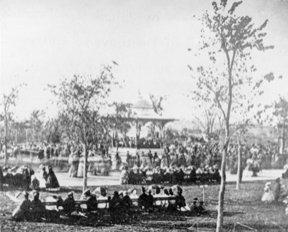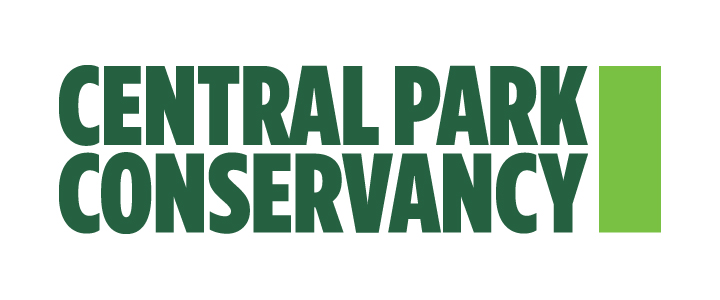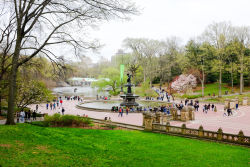Central Park
The Daily Plant : Thursday, September 23, 2004
HOW TO GET TO CARNEGIE HALL

Many children, especially those who practiced music, were once told that there was only one way to get to Carnegie Hall—by practicing; but this week I found another—by visiting the archives.
All New York City’s archivists hang out together. In fact, there are monthly meetings of the Archivists Roundtable, where talk of preservation grants and cataloging precedes a keynote speech on any number of fascinating topics. In June of this year, thanks to the efforts of Photo Archivist Sachiko Onishi, the Arsenal played host to this meeting. Yours truly, along with Historian Scott Sendrow and Director of Art and Antiquities Jonathan Kuhn, made the presentations. The corps of archivists said they were the best lectures since the talk on the de-acidification of steam-pressed pulp (that means they liked it).
More important than swapping notes on which cataloging system we use, the archivists of New York got to find out about the Parks & Recreation Library and its holdings. In this sense, the world of library science is just like everything else; it all comes down to whom you know. Apparently, one of the people in the audience that night was the archivist from Carnegie Hall, and so when she received a large donation of materials that included an 1884 Central Park concert schedule, she knew that this relic’s proper home was the Parks Library.
Not unlike the Parks Library, to which many more people come in proximity than actually visit, the archive at Carnegie Hall is situated in such a way that no one who comes to see a concert is ever more than 200 feet from it, and the cheaper your seats, the closer you get. The archives sit directly above the circle of lights in the center of the main hall’s ceiling.
The archivist presented me with a hardcover, bound booklet whose spine had cracked and whose pages had yellowed over the years, but which was otherwise in remarkable condition. It contained a full set of programs from the Parks summer concert series of 1884. Think for a second how long ago that was. In 1884, the Brooklyn Bridge was one year old and there were only 38 states in the Union; nevertheless, there were dozens of free, public music concerts in Central, Battery and East River Parks.
Naturally, Parks & Recreation’s records note the existence of these concerts, but not until now did we have a record of what songs were played, who performed, and, most importantly, what advertisements were included in the programs. According to the programs, the concert season of 1884 began in Central Park on June 4, at 4 p.m., with C. A. Cappa’s 7th Regiment Band. The "programme" began with a march by Cappa himself called Produce Exchange, followed by pieces by Mendelssohn, Verdi and Wagner.
For the historian trying to cull meaning from this program, the advertisements, which take up three quarters of the one-page program, tell a lot about the times and the people. There are five different piano company ads, which implies that the expected audience for this Wednesday afternoon concert was made up of primarily of middle to upper class women.
At the time, owning a piano was the mark of a good middle class home. One can assume that the audience was primarily female by virtue of the fact that it was at 4 p.m., a time when middle class women did not generally work. The other advertisements for ovens, soaps, toilet water, beauty products, dancing school and women’s shoes support this assertion. There’s even one ad for "shoe dressing," the shining and softening of shoes, especially those of ladies and children. There was a sale for shoe dressing at Lord & Taylor on 20th Street as well as at other department stores on 14th and 28th Streets, and on Fulton Street in Brooklyn.
Overall, this compilation shows just how different the world of 1884 was from that of today. Whereas the music lovers of today with the necessary cash spring for an i-pod, 120 years ago their only choice was to buy a piano and teach one of their kids to play it. Most stoves ran on coal or wood, and mothers had to soften their children’s boots with "Raven Gloss."
But as LeVar Burton said famously, "You don’t have to take my word for it." Just come by the Parks Library and see for yourself.
Written by John Mattera
Parks Librarian
QUOTATION FOR THE DAY
"The wise man questions the wisdom of others because he questions his own, the foolish man, because it is different from his own."
Leo Stein
(1872-1947)
Check out your park's Vital Signs
Clean & Safe
Green & Resilient
Empowered & Engaged Users
Share your feedback or learn more about how this park is part of a
Vital Park System

Know Before You Go
Anticipated Completion: Spring 2024
Anticipated Completion: Spring 2025

Contacts
Central Park Information: (212) 310-6600
Central Park Information (for the Hearing Impaired): (800) 281-5722
Belvedere Castle, The Henry Luce Nature Observatory: (212) 772-0210
The Charles A. Dana Discovery Center: (212) 860-1370
The Dairy Visitor Center and Gift Shop: (212) 794-6564
North Meadow Recreation Center: (212) 348-4867
Loeb Boathouse (Bike rentals, boat rentals & gondolas): (212) 517-2233
Carousel: (212) 879-0244
Fishing at Harlem Meer (Catch & Release): (212) 860-1370
Harlem Meer Performance Festival: (212) 860-1370
Horseback Riding - Claremont Stables: (212) 724-5100
Metropolitan Opera (Performances on the Great Lawn): (212) 362-6000
New York Philharmonic (Performances on the Great Lawn): (212) 875-5709
Shakespeare in the Park - The Public Theater at the Delacorte Theater: (212) 539-8655
Central Park SummerStage: (212) 360-2777
Swedish Cottage Marionette Theater: (212) 988-9093
Tennis: (212) 280-0205
Weddings, Ceremonies and Photography at the Conservatory Garden: (212) 360-2766
Wildlife Center & Tisch Children's Zoo: (212) 439-6500











